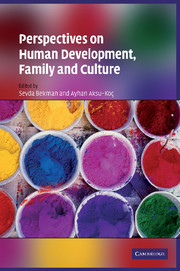Book contents
- Frontmatter
- Contents
- List of figures
- List of tables
- List of contributors
- Preface
- Foreword
- Selected international publications by Çiğdem Kağıtçıbaşı
- I Cultural and cross-cultural psychology: selected perspectives
- II Development in the family context
- 5 Organizing principles and processes from developmental science for culture and caregiving
- 6 A social change and human development perspective on the value of children
- 7 Turkish family structure and functioning
- 8 Mothers' and fathers' child-rearing practices and self-esteem in three generations of urban Turkish families
- III Culture and self
- IV Social change, family, and gender
- V Induced change
- Epilogue
- Subject Index
- Author Index
- References
8 - Mothers' and fathers' child-rearing practices and self-esteem in three generations of urban Turkish families
Published online by Cambridge University Press: 04 August 2010
- Frontmatter
- Contents
- List of figures
- List of tables
- List of contributors
- Preface
- Foreword
- Selected international publications by Çiğdem Kağıtçıbaşı
- I Cultural and cross-cultural psychology: selected perspectives
- II Development in the family context
- 5 Organizing principles and processes from developmental science for culture and caregiving
- 6 A social change and human development perspective on the value of children
- 7 Turkish family structure and functioning
- 8 Mothers' and fathers' child-rearing practices and self-esteem in three generations of urban Turkish families
- III Culture and self
- IV Social change, family, and gender
- V Induced change
- Epilogue
- Subject Index
- Author Index
- References
Summary
In Turkish, when you want to talk about an old friend, you might say “my friend of forty years” – usually an exaggeration, but when I talk about Çiğdem it is literally true. We first met in Berkeley, when she was just finishing up her doctoral dissertation and I had not yet started the program, and we have continued as friends, colleagues, and collaborators through all the years I have been in Turkey. No one could ask for a more loyal friend, a more stimulating colleague or a more energetic and hard-working research collaborator than Ciğdem. But she has also earned my special admiration as a psychologist who works to “give psychology away to the public,” in George Miller's phrase, contributing enormously to the establishment of the Mother–Child Education Foundation and its programs, bringing important issues into public debate through popular articles and television appearances, and taking a leading role in the development of professional and academic psychology in Turkey. It has been a privilege to know and work with her for these “forty years.”
The aim of the research reported in this chapter was to investigate the relationship to self-esteem of child-rearing practices of mothers and fathers in three generations of urban middle class Turkish families. A second aim was to investigate similarities and differences between mothers and fathers with regard to several dimensions in their parenting practices with sons and daughters – in other words, to examine the role of both sex of parent and sex of child in parenting practices.
- Type
- Chapter
- Information
- Perspectives on Human Development, Family, and Culture , pp. 126 - 140Publisher: Cambridge University PressPrint publication year: 2009
References
- 12
- Cited by



